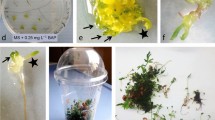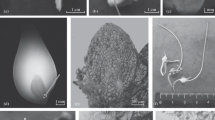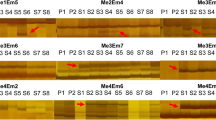Abstract
In vitro regeneration of Viola stagnina Kit., endangered in most part of its European distribution range, was successfully obtained based on the newly developed protocol. Adventitious shoots via direct and indirect organogenesis were induced on leaf blade and petiole fragments on solidified Murashige and Skoog (MS) medium supplemented with 0.5 or 1 mg l−1 thidiazuron, respectively. Shoots were rooted on half-strength MS medium with 2% sucrose and 0.5 mg l−1 indole-3-acetic acid (IAA), and plantlets were successfully acclimatized. Sixty-five of the regenerated plants (72% of isolated shoots cultured on rooting medium) survived at the experimental plot conditions. Among recovered via organogenesis plants, individuals ‘true-to-type’ derived from initial plant G1 and also plants genetically distant from initial plants were detected by ISSR markers. In all groups of clones genetic indices (number of genotypes, polymorphic markers, gene diversity, total gene diversity, mean gene diversity) were lower than in natural populations. Regenerated plantlets had the same genome size estimated by flow cytometry as initial material and plants from natural populations. They developed chasmogamous flowers with highly viable pollen grains (over 90%), cleistogamous flowers, and set seeds from both flower types in the first and second seasons cultivated at experimental plots. This is the first report of a successfully developed micropropagation protocol of V. stagnina, and the first detailed genetic analysis of recovered plants with the use of ISSR markers and genome size measurements allowing to discuss the advantageous role of somaclonal variation in ex situ plant conservation with the use of in vitro micropropagation.



Similar content being viewed by others
References
Abdellatif KF, Hegazy AE, Aboshama HM, Emara HA, El-Shahed AA (2012) Morphological and molecular characterization of somaclonal variation in tissue culture-derived banana plants. J Genet Eng Biotechnol 10:47–53
Avila-Treviño JA, Muñoz-Alemán JM, Pérez-Molphe-Balch E, Rodríguez-Sahagún A, Morales-Domínguez JF (2017) In vitro propagation from bud and apex explants of Moringa oleifera and evaluation of the genetic stability with RAMP marker. S Afr J Bot 108:149–156
Bairu MW, Aremu AO, van Staden J (2011) Somaclonal variation in plants: causes and detection methods. Plant Growth Regul 63:147–173
Bandelt H, Forster P, Röhl A (1999) Median-joining networks for inferring intraspecific phylogenies. Mol Biol Evol 16(1):37–48
Barow M (2006) Endopolyploidy in seed plants. BioEssays 28:271–281
Bayliss MW (1973) Origin of chromosome number variation in cultured plant cells. Nature 246:529–530
Bhattacharyya P, Kumar V, van Staden J (2017) Assessment of genetic stability amongst micropropagated Ansellia africana, a vulnerable medicinal orchid species of Africa using SCoT markers. S Afr J Bot 108:294–302
Bidwell SD, Pederick JW, Sommer-Knudsen J, Woodrow IE (2001) Micropropagation of the nickel hyperaccumulator, Hybanthus floribundus (Family Violaceae). Plant Cell Tissue Organ 67:89–92
Bonin A, Bellemain E, Bronken Eidesen P, Pompanon F, Brochmann C, Taberlet P (2004) How to track and assess genotyping errors in population genetics studies. Mol Ecol 13:3261–3273
Chalageri G, Babu UV (2012) In vitro plant regeneration via petiole callus of Viola patrinii and genetic fidelity assessment using RAPD markers. Turk J Bot 36:358–368
Curtis TGF, McGough HN (1988) The Irish Red Data Book 1. Vascular plants. Wildlife Service Ireland, Stationary Office, Dublin
D’Amato FD, Bayliss MW (1985) Cytogenetics of plant cell and tissue cultures and their regenerates. Critical Rev Plant Sci 3:73–112
Dafni A, Firmage D (2000) Pollen viability and longevity: practical, ecological and evolutionary implications. In: Dafni A, Hesse M, Pacini E (eds) Pollen and pollination. Springer, Vienna, pp 113–132
Danihelka J, Niklfeld H, Šípošová H (2009) Viola elatior, V. pumila and V. stagnina in Austria, Czechia and Slovakia: a story of decline. Preslia 81:151–171
Dhooghe E, van Laere K, Eeckhaut T, Leus L, van Huylenbroeck J (2011) Mitotic chromosome doubling of plant tissues in vitro. Plant Cell Tissue Organ Cult 104:359–373
Doležel J (1997) Application of flow cytometry for the study of plant genomes. J Appl Genet 38:285–302
Doležel J, Sgorbati S, Lucretti S (1992) Comparison of three DNA fluorochromes for flow cytometric estimation of nuclear DNA content in plants. Physiol Plant 85:625–631
Eckstein RL, Otte A (2005) Effects of cleistogamy and pollen source on seed production and offspring performance in three endangered violets. Basic Appl Ecol 6(4):339–350
Eckstein RL, Hölzel N, Danihelka J (2006a) Biological flora of Central Europe: Viola elatior, V. pumila and V. stagnina. Perspect Plant Ecol 8:45–66
Eckstein RL, O’Neill RA, Danihelka J, Otte A, Köhler W (2006b) Genetic structure among and within peripheral and central populations of three endangered floodplain violets. Mol Ecol 15:2367–2379
Excoffier L, Laval G, Schneider S (2005) Arlequin (version 3.0): an integrated software package for population genetics data analysis. Evol Bioinform Online 1:47–50
Feráková V, Maglocký Š, Marhold K (2001) Red list of ferns and flowering plants of Slovakia. In: Baláž D, Marhold K, Urban P (eds) Červený zoznam rastlín a živočíchov Slovenska. Red list of plants and animals of Slovakia. Ochr Prír 20(suppl 160):44–77 (In Slovak)
Gilissen LJW, van Staveren MJ, Hakkert JC, Smulders MJM, Verhoeven HA, Creemers-Molenaar J (1994) The competence of cells for cell division and regeneration in tobacco explants depends on cellular location, cell cycle phase and ploidy level. Plant Sci 103:81–91
Greilhuber J, Doležel J, Lysák MA, Bennett MD (2005) The origin, evolution and proposed stabilization of the terms ‘genome size’ and ‘C-value’ to describe nuclear DNA contents. Ann Bot 95(1):255–260
Grulich V (2012) Red List of vascular plants of the Czech Republic. Preslia 84(3):631–645
Haque SM, Ghosh B (2013) Micropropagation, in vitro flowering and cytological studies of Bacopa chamaedryoides, an ethno-medicinal plant. Environ Exp Bot 11:59–68
Huson DH, Bryant D (2006) Application of phylogenetic networks in evolutionary studies. Mol Biol Evol 23(2):254–267
Karp A (1994) Origins, causes and uses of variation in plant tissue cultures. In: Vasil IK, Thorpe TA (eds) Plant cell and tissue culture. Kluwer Academic Publishers, Dordrecht, pp 139–152
Kaźmierczakowa R, Zarzycki K, Mirek Z (2014) Polish Red Data book of plants. Pteridophytes and flowering plants. Instytut Ochrony Przyrody. Polska Akademia Nauk, Cracow
Kolano B, Siwinska D, Maluszynska J (2009) Endopolyploidy patterns during development of Chenopodium quinoa. Acta Biol Crac Ser Bot 51(2):85–92
Korneck D, Schnittler M, Vollmer I (1996) Red List of vascular plants (Pteridophyta et Spermatophyta) Germany. Schr Reihe Veg Kd 28:21–187 (In German)
Krishna H, Alizadeh M, Singh D, Singh U, Chauhan N, Eftekhari M, Sadh RK (2016) Somaclonal variations and their applications in horticultural crops improvement. 3 Biotech 6:54. https://doi.org/10.1007/s13205-016-0389-7
Kubaláková M, Doležel J, Lebeda A (1996) Ploidy instability of embryogenic cucumber (Cucumis sativus L.) callus culture. Biol Plant 38:475–480
Kuta E (1990) Biosystematic studies on the genus Viola L.; section Plagiostigma Godr. II. Embryological analysis of V. epipsila Ledeb. V. palustris L. and their hybrids from Poland. Acta Biol Crac Ser Bot 31:46–62
Kuta E (1976) Viola L. In: Skalińska M, Jankun A, Wcisło H et al (eds) Further studies in chromosome numbers of polish angiosperms. Eleventh contribution. Acta Biol Crac Ser Bot 19:107–148
Kuta E, Jedrzejczyk-Korycińsk M, Cieślak E, Rostański A, Szczepaniak M, Migdałek G, Wąsowicz P, Suda J, Combik M, Słomka A (2014) Morphological versus genetic diversity of Viola reichenbachiana and V. riviniana (sect. Viola, Violaceae) from soils differing in heavy metal content. Plant Biol 16(5):924–934
Larkin PJ, Scowcroft WR (1981) Somaclonal variation—a novel source of variability from cell cultures for plant improvement. Theor Appl Genet 60:197–214
Lee M, Phillips RL (1988) The chromosomal basis of somaclonal variation. Ann Rev Plant Physiol Plant Mol Biol 39:413–437
Leigh JW, Bryant D (2015) PopART: full-feature software for haplotype network construction. Methods Ecol Evol 6(9):1110–1116
Lemontey C, Mousset-Déclas C, Munier-Jolain N, Boutin JP (2000) Maternal genotype influences pea seed size by controlling both mitotic activity during early embryogenesis and final endoreduplication level/cotyledon cell size in mature seed. J Exp Bot 51:167–175
Leva AR, Petruccelli R, Rinaldi LMR (2012) Somaclonal variation in tissue culture: a case study with olive. In: Leva A (ed) Recent advances in plant in vitro culture. InTech, Rijeka
Li JT, Deng DM, Peng GT, Deng JC, Zhang J, Liao B (2010) Successful micropropagation of the cadmium hyperaccumulator Viola baoshanensis (Violaceae). Int J Phytoremediat 12(8):761–771
Mallon R, Rodriguez-Oubina J, Gonzalez ML (2010) In vitro propagation of the endangered plant Centaurea ultreiae: assessment of genetic stability by cytological studies, flow cytometry and RAPD analysis. Plant Cell Tissue Organ Cult 101:31–39
Maluszynska J, Kolano B, Sas-Nowosielska H (2012) Endopolyploidy in plants. In: Leitch IJ, Greilhuber J, Doležel J, Wendel J (eds) Plant genome diversity, vol 2, Springer, Vienna, pp 99–119
Marcussen T, Nordal I (1998) Viola suavis, a new species in the Nordic flora, with analyses of the relation to other species in the subsection Viola (Violaceae). Nord J Bot 18:221–237
Migdałek G (2015) Population genetic diversity and relationships between two closely related forest violets V. reichenbachiana Jordan ex Bor. and V. riviniana Rchb. (Violaceae) based on nuclear, plastid and AFLP markers. Dissertation, Jagiellonian University
Migdałek G, Kolczyk J, Pliszko A, Kościńska-Pająk M, Słomka A (2014) Reduced pollen viability and achene development in Solidago × niederederi Khek from Poland. Acta Soc Bot Pol 83(3):251–255
Mokhtari A, Otroshy M, Barekat T (2015) Plant regeneration through callus induction on medicinal herb Viola odorata—role of plant growth regulator and explants. Agric For 61(3):161–170
Murashige T, Skoog F (1962) A revised medium for rapid growth and bioassays with tobacco tissue cultures. Physiol Plant 15:473–497
Naeem M, Naveed I, Naqvi SMS, Mahmood T (2013) Standardization of tissue culture conditions and estimation of free scavenging activity in Viola odorata L. Pak J Bot 45:197–202
Neelakandan AK, Wang K (2012) Recent progress in the understanding of tissue culture-induced genome level changes in plants and potential applications. Plant Cell Rep 31:597–620
Nei M (1973) Analysis of gene diversity in subdivided populations. Proc Natl Acad Sci 70(12):3321–3323
Nei M, Li WH (1979) Mathematical model for studying genetic variation in terms of restriction endonucleases. Proc Natl Acad Sci 76(10):5269–5273
Niklfeld H, Schratt-Ehrendorfer L (1999) Red List of endangered ferns and flowering plants (Pteridophyta and Spermatophyta) In: Niklfeld H (ed) Rote Listen gefährdeter Pflanzen Österreichs. Red Lists of threatened plants in Austria, 2nd edn. Bundesministerium für Umwelt, Jugend und Familie, Wien, pp 33–130
Nybom H, Weising K, Rotter B (2014) DNA fingerprinting in botany: past, present, future. Investig Genet 5:1
Ochatt SJ, Patat-Ochatt EM, Moessner A (2011) Ploidy level determination within the context of in vitro breeding. Plant Cell Tissue Organ Cult 104:329–341
Otto F (1990) DAPI staining of fixed cells for high-resolution flow cytometry of nuclear DNA. Methods Cell Biol 33:105–110
Phillips RL, Kaeppler SM, Olhoft P (1996) Genetic instability of plant tissue cultures: breakdown of normal controls. Proc Natl Acad Sci USA 91:5222–5226
Pontaroli AC, Camadro EL (2005) Somaclonal variation in Asparagus officinalis plants regenerated by organogenesis from long-term callus cultures. Genet Mol Biol 28:423–430
Popielarska-Konieczna M, Kozieradzka-Kiszkurno M, Świerczyńska J, Góralski G, Ślesak H, Bohdanowicz J (2008) Ultrastructure and histochemical analysis of extracellular matrix surface network in kiwifruit endosperm-derived callus culture. Plant Cell Rep 27(7):1137–1145
Popielarska-Konieczna M, Kozieradzka-Kiszkurno M, Tuleja M, Ślesak H, Kapusta P, Marcińska I, Bohdanowicz J (2013) Genotype-dependent efficiency of endosperm development in culture of selected cereals: histological and ultrastructural studies. Protoplasma 250:361–369. https://doi.org/10.1007/s00709-012-0419-1
Prakash E, Sha Valli Khan PS, Sairam Reddy P, Rao KR (1999) Regeneration of plants from seed-derived callus of Hybanthus enneaspermus L. Muell., a rare ethnobotanical herb. Plant Cell Rep 18:873–878
Rodriguez-Enriquez J, Dickinson HG, Grant-Downton RT (2011) MicroRNA misregulation: an overlooked factor generating somaclonal variation? Trends Plant Sci 16:242–248
Sato T, Kwon OC, Miyake H, Taniguchi T, Maeda E (1995) Regeneration of plantlets from petiole callus of wild viola (Viola patrinii DC.). Plant Cell Rep 14:768–772
Schlüter PM, Harris SA (2006) Analysis of multilocus fingerprinting data sets containing missing data. Mol Ecol Notes 6(2):569–572
Sebastiani MS, Ficcadenti N (2016) In vitro plant regeneration from cotyledonary explants of Cucumis melo L. var. cantalupensis and genetic stability evaluation using RAPD analysis. Plant Cell Tissue Organ 124:69–79
Shan X, Li Y, Tan M, Zhao Q (2012) Tissue culture-induced alteration in cytosine methylation in new rice recombinant inbred lines. Afr J Biotechnol 11:4338–4344
Singh RJ (2003) Plant Cytogenetics. 2nd ed. CRC Press, Boca Raton
Slazak B, Sliwinska E, Saluga M, Ronikier M, Bujak J, Słomka A, Göransson U, Kuta E (2015a) Micropropagation of Viola uliginosa (Violaceae) for endangered species conservation and for somaclonal variation-enhanced cyclotide biosynthesis. Plant Cell Tissue Organ 120:179–190
Slazak B, Jacobsson E, Göransson U, Kuta E (2015b) Exogenous plant hormones and cyclotide expression in Viola uliginosa (Violaceae). Phytochemistry 117:527–536
Słomka A, Kawalec P, Kellner K, Jędrzejczyk-Korycińska M, Rostański A, Kuta E (2010) Was reduced pollen viability in Viola tricolor L. the result of heavy metal pollution or rather the tests applied? Acta Biol Crac Ser Bot 52(1):123–127
Słomka A, Jedrzejczyk-Korycinska M, Rostanski A, Karcz J, Kawalec P, Kuta E (2012) Heavy metals in soil affect reproductive processes more than morphological characters in Viola tricolor. Environ Exp Bot 75:204–211
Soni M, Kaur R (2014) Rapid in vitro propagation, conservation and analysis of genetic stability of Viola pilosa. Physiol Mol Biol Plants 20(1):95–101
Stepansky A, Kovalski I, Perl-Treves R (1999) Intraspecific classification of melons (Cucumis melo L.) in view of their phenotypic and molecular variation. Plant Syst Evol 271:313–332
Thiem B, Sliwinska E (2003) Flow cytometric analysis of nuclear DNA content in cloudberry (Rubus chamaemorus L.) in vitro cultures. Plant Sci 164:129–134
Viehmannova I, Bortlova Z, Vitamvas J, Hlasna Cepkova P, Eliasova K, Svobodova E, Travnickova M (2014) Assessment of somaclonal variation in somatic embryo-derived plants of yacon Smallanthus sonchifolius (Poepp. and Endl.) H. Robinson using inter simple sequence repeat analysis and flow cytometry. Electron J Biotechnol 17(2):102–106
Vishwakarma U, Gurav A, Sharma P (2013) Regeneration of multiple shoots from petiole callus of Viola serpens Wall. Pharmacogn Res 5(2):86–92
Wang J, Bao MZ (2007) Plant regeneration of pansy (Viola wittrockiana) ‘Caidie’ via petiole-derived callus. Sci Hortic 111:266–270
Wang QM, Wang L (2012) An evolutionary view of plant tissue culture: somaclonal variation and selection. Plant Cell Rep 31(9):1535–1547
Wiggington MJ (1999) British Red Data books 1. Vascular plants. Joint Nature Conservation Committee, Peterborough
Wijowska M, Kuta E, Przywara L (1999) Autonomous endosperm induction by in vitro culture of unfertilized ovules of Viola odorata L. Sex Plant Reprod 12:164–170
Yeh FC, Yang RC, Boyle T (1999) PopGene version 1.31: Microsoft Window-based freeware for population genetic analysis. Centre for International Forestry Research, University of Alberta, Edmonton, pp 11–23
Żabicki P, Kuta E, Tuleja M, Rataj K, Malec P (2013) Arabidopsis cyclin-dependent kinase gene Cdkg;2 is involved in organogenic responses induced in vitro. Acta Biol Crac Ser Bot 55(1):37–48
Zarzycki K, Szeląg Z (2006) Red list of vascular plants in Poland. In: Mirek Z, Zarzycki K, Wojewoda W, Szeląg Z (eds) Red list of plants and fungi in Poland. Szafer Institute of Botany, Polish Academy of Sciences, Cracow, pp 11–20
Acknowledgements
Authors would like to thank dr. Artur Pliszko from Institute of Botany, Jagiellonian University and Drs. Ryszard Marecki and Tomasz S. Olszewski from Gdansk University for their help in collecting of plant material. This work was funded in part by the Dean of the Faculty of Biology and Earth Sciences of Jagiellonian University (Project DS/MND/WBiNoZ/IB/25/2012 for P. Żabicki).
Author information
Authors and Affiliations
Contributions
All Authors made substantial contributions to conception and design, acquisition of data, analysis and interpretation of data, participated in drafting the article or revising it critically. PŻ study conception and design, acquisition of data, analysis and interpretation of data, drafting of manuscript; EŚ performed and evaluated flow cytometric analyses and participated in writing the manuscript; JM conducted calculations of genetic indices; AS acquisition, analysis and interpretation of data; MT acquisition of data, participated in drafting the article; GM analysis and interpretation of data, participated in drafting the manuscript; JŻ analysis and interpretation of data, participated in revising the manuscript; AS acquisition of data, participated in revising the manuscript; MK participated in revising the manuscript and formatting it according to instructions for authors; EK contribution to interpretation of data, supervising experiments, critical revision of the manuscript.
Corresponding author
Ethics declarations
Conflict of interest
The authors declare that they have no conflict of interest.
Additional information
Communicated by Sergio J. Ochatt.
Electronic supplementary material
Below is the link to the electronic supplementary material.
Rights and permissions
About this article
Cite this article
Żabicki, P., Sliwinska, E., Mitka, J. et al. Does somaclonal variation play advantageous role in conservation practice of endangered species?: comprehensive genetic studies of in vitro propagated plantlets of Viola stagnina Kit. (Violaceae). Plant Cell Tiss Organ Cult 136, 339–352 (2019). https://doi.org/10.1007/s11240-018-1519-1
Received:
Accepted:
Published:
Issue Date:
DOI: https://doi.org/10.1007/s11240-018-1519-1




